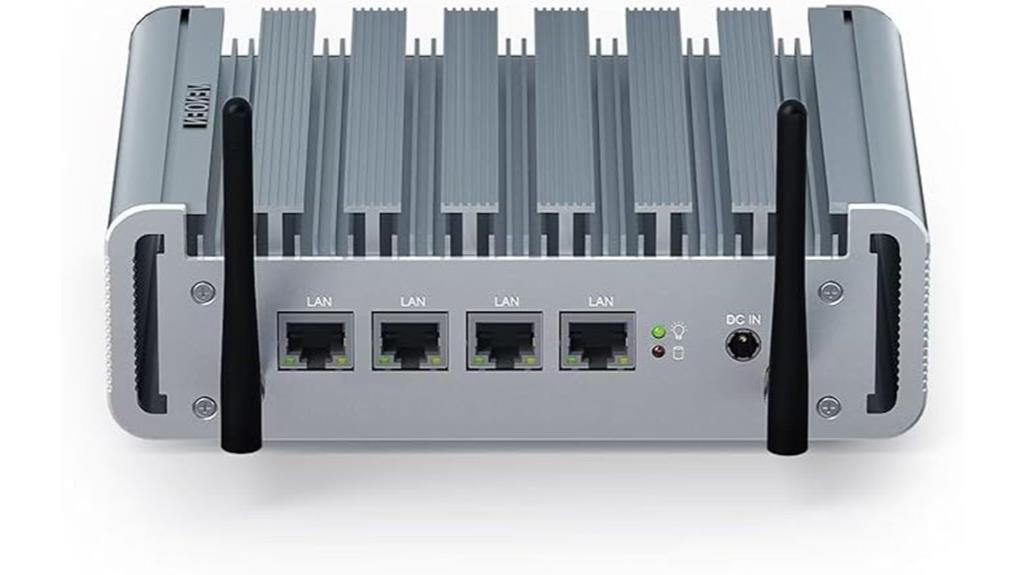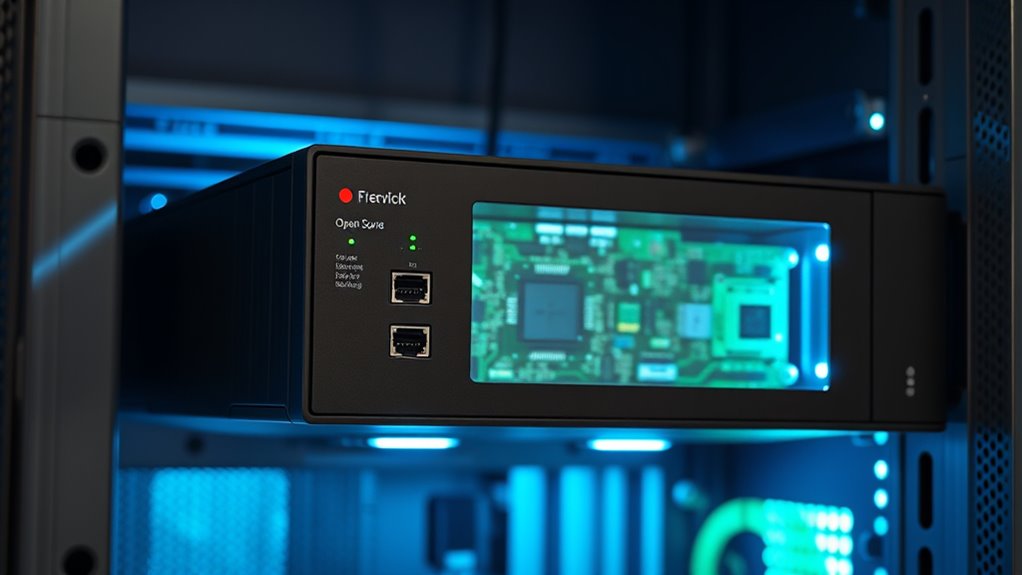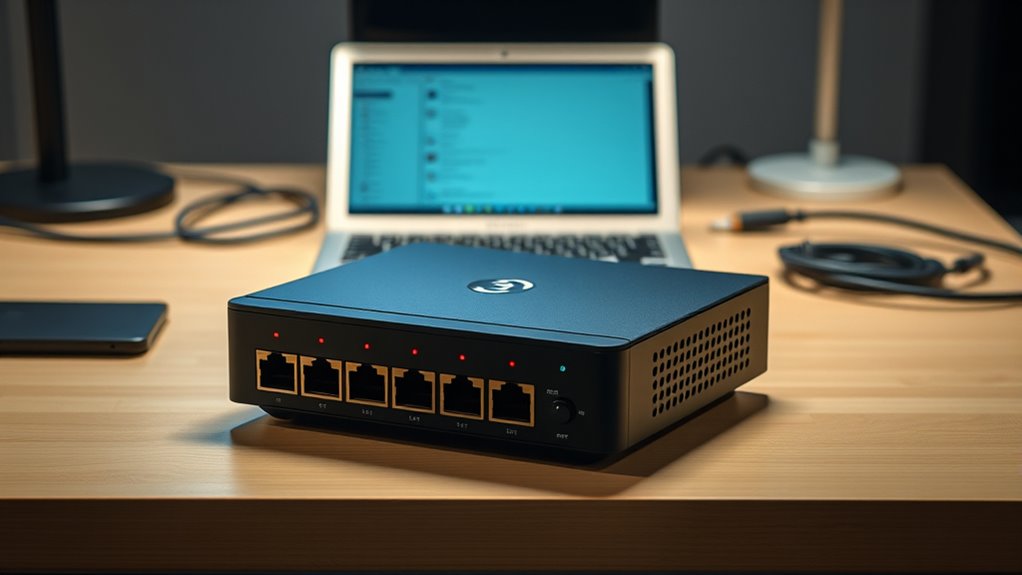Based on my experience, the VENOEN Firewall Micro Appliance with a Celeron J4125 processor stands out as the best open-source option for balancing security and flexibility. It offers solid hardware compatibility, including multiple network interfaces and room for future expansion, all while supporting virtualization platforms. Its processing power ensures smooth traffic inspection without bottlenecks. If you want detailed insights on choosing the perfect firewall appliance, keep exploring the key factors involved.
Key Takeaways
- pfSense offers robust security features with extensive customization options and a strong open-source community support.
- It supports virtualization platforms like ESXI and PVE, enabling flexible deployment on various hardware setups.
- Compatible with multiple network interfaces, including gigabit and SFP ports, for scalable and high-performance networking.
- Regular updates and active community ensure ongoing security patches, feature improvements, and reliable support.
- Designed for hardware expandability, allowing easy upgrades in RAM, storage, and network interfaces to meet evolving needs.
VENOEN Firewall Micro Appliance with Celeron J4125 Processor

If you’re looking for a reliable and versatile open-source firewall solution, the VENOEN Firewall Micro Appliance with the Celeron J4125 processor is an excellent choice. This compact device packs a quad-core CPU running up to 2.70 GHz, supporting virtualization platforms like ESXI and PVE. It’s compatible with Windows, Linux, and open-source systems such as OPNsense. The appliance features high-speed 2.5GbE LAN ports, dual display outputs, and expandable storage options. Its fanless, dust-proof design guarantees silent, 24/7 operation, making it perfect for secure network management in both home and business environments.
Best For: small to medium-sized businesses and tech-savvy home users seeking a reliable, high-performance open-source firewall and network security appliance.
Pros:
- Supports virtualization platforms like ESXI and PVE with VT-X and VT-D capabilities.
- Equipped with four 2.5GbE LAN ports for high-speed network connectivity.
- Fanless, dust-proof design ensures silent, continuous 24/7 operation and longer hardware lifespan.
Cons:
- No RAM or SSD included, requiring users to purchase and install their own components.
- Limited expansion options beyond storage and RAM upgrades.
- May require technical expertise for setup and configuration of open-source firewall systems.
Factors to Consider When Choosing Open‑Source Firewall Appliances

When selecting an open-source firewall appliance, I consider hardware compatibility, processing power, and storage options to guarantee it meets my network demands. I also evaluate network interface choices and ongoing software support to keep my system secure and flexible. Understanding these factors helps me choose an appliance that fits both my technical needs and future growth.
Hardware Compatibility Requirements
Choosing the right open-source firewall appliance hinges on guaranteeing the hardware meets specific compatibility requirements. First, check if the processor supports virtualization technologies like VT-X and VT-D, especially if you plan to run multiple virtual environments. Next, verify that the device has enough RAM and storage that align with the software’s needs to assure smooth operation. Network interfaces are also critical; confirm that LAN ports and Wi-Fi modules are compatible with your desired network setup. Hardware acceleration features such as AES-NI can substantially boost encryption performance, so it’s worth verifying support for those. Finally, guarantee the physical connectors and display outputs suit your deployment environment and management preferences, providing enough flexibility for your specific setup.
Processing Power Needs
The processing power of a firewall appliance is essential because it directly impacts how well the device can handle multiple connections and perform complex security tasks simultaneously. A powerful CPU allows for effective inspection of network traffic, including deep packet analysis and intrusion detection. In high-bandwidth environments or with many connected devices, a multi-core processor—such as quad-core or higher—is often necessary to prevent bottlenecks. Insufficient processing power can cause lag, degraded performance, and security vulnerabilities by delaying threat detection. To guarantee optimal performance and network security, it’s critical to balance the firewall’s processing capabilities with your specific load requirements. This balance helps maintain smooth operation, even during peak traffic, and keeps your network protected.
Expandability and Storage
Expandability and storage are essential factors because they determine how well an open-source firewall appliance can grow with your network’s evolving needs. I look for devices that support adding RAM, storage, and network interfaces easily, ensuring future upgrades don’t require a complete replacement. Support for M.2 SATA and SATA 3.0 ports makes installing SSDs and HDDs straightforward, boosting storage capacity when needed. Compatibility with virtualization platforms like ESXI and PVE offers flexible deployment options and efficient resource management. Upgrading components like RAM and storage can profoundly extend the appliance’s lifespan and improve performance. Additionally, a modular design facilitates hardware expansion without major disruptions, giving me peace of mind that my firewall can adapt to increasing security demands and data volumes over time.
Network Interface Options
Have you ever wondered how the number and type of network interfaces affect an open-source firewall appliance’s performance and flexibility? The interfaces determine how well the appliance handles traffic, scales, and integrates into your network. Multiple Ethernet ports, from 1GbE to 10GbE, boost throughput and support diverse bandwidth needs. Some appliances include SFP or SFP+ slots for fiber optic connections, enabling long-distance or high-speed links. Supporting VLAN tagging and link aggregation enhances network segmentation and bandwidth management. The more interfaces available, the more adaptable your deployment—whether as a firewall, router, or multi-WAN load balancer. Carefully choosing the right combination guarantees your firewall can adapt to current demands and future growth, balancing performance with expandability.
Software Support and Updates
Choosing an open-source firewall appliance requires careful consideration of software support and updates, as these guarantee your device stays secure and functional over time. Active community support provides regular updates, patches, and security fixes that are essential for maintaining protection against emerging threats. Compatibility with the latest versions of open-source software ensures you can access new features and improvements. Frequent updates help address vulnerabilities and bugs, preserving the appliance’s security integrity. Additionally, ongoing firmware and software updates from developers optimize performance and stability. Community-driven resources, including documentation and troubleshooting guides, make maintenance and upgrades more manageable. Overall, reliable support and timely updates are indispensable to keeping your firewall effective, secure, and adaptable to evolving network needs.
Frequently Asked Questions
How Does Open-Source Firewall Software Compare to Proprietary Solutions?
Open-source firewall software offers great flexibility and transparency that proprietary solutions often lack. I appreciate how I can customize and audit open-source options to fit my specific needs, plus I save on costs. While proprietary firewalls might offer more polished support, I find open-source tools provide robust security and community-driven updates. Overall, I prefer open-source for its adaptability and cost-effectiveness, especially when I want control over my security infrastructure.
Can Open-Source Firewalls Support Enterprise-Level Network Environments?
Absolutely, open-source firewalls can support enterprise-level networks. I’ve seen many organizations scale their open-source solutions effectively, customizing them to fit complex environments. They offer robust security features, flexibility, and cost savings, which are essential for large networks. With proper configuration and ongoing management, open-source firewalls can match proprietary solutions in performance, providing reliable protection without sacrificing adaptability.
What Are the Typical Maintenance Requirements for Open-Source Firewall Appliances?
Maintaining open-source firewall appliances means managing updates, monitoring performance, and troubleshooting issues regularly. I check for security patches and software updates to keep defenses strong, while also reviewing logs to spot suspicious activity. It’s essential to stay proactive, performing routine backups and configurations. Staying vigilant ensures my firewall remains secure, flexible, and functioning flawlessly, so my network stays safe and sound without sacrificing speed or stability.
Are There Any Security Risks Associated With Open-Source Firewall Solutions?
Yes, there are security risks with open-source firewall solutions, but they’re often manageable. Since the code is open, vulnerabilities can be spotted and fixed quickly when a community actively maintains it. However, if updates are neglected or the community is inactive, security gaps could emerge. I recommend staying vigilant, applying updates promptly, and choosing well-supported projects to minimize risks and keep your network secure.
How Customizable Are Open-Source Firewalls for Specific Organizational Needs?
Open-source firewalls are incredibly customizable; I’ve personally tailored one for a small business, adjusting rules and adding plugins to meet their specific needs. For instance, I integrated custom VPN protocols and refined traffic filtering, ensuring peak security without sacrificing flexibility. This level of customization allows organizations to adapt the firewall precisely to their unique requirements, making open-source solutions highly versatile and effective for diverse environments.
Conclusion
In the end, choosing the right open-source firewall appliance depends on your specific needs, but remember, “a chain is only as strong as its weakest link.” The VENOEN Firewall Micro Appliance with its Celeron J4125 processor offers a solid balance of security and flexibility. Take the time to evaluate hardware, expandability, and support to guarantee your network stays protected and adaptable. Trust me, investing wisely today pays off in peace of mind tomorrow.









